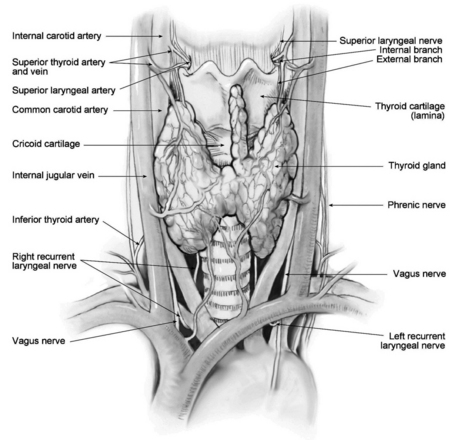39 Care of the thyroid and parathyroid surgical patient
Bilateral Subtotal Thyroidectomy: Removal of most of the thyroid tissue in both lobes with a small remnant of thyroid tissue left at the back portion of the thyroid to protect the parathyroid glands and prevent recurrent laryngeal nerve damage (a potential complication associated with total thyroidectomy).
Parathyroidectomy: Excision of one or more diseased parathyroid glands.
Subtotal/Partial Thyroidectomy: Removal of the thyroid gland with the exception of a small portion retained on the opposite side of the thyroid.
Thyroidectomy: Total excision of the thyroid gland with the parathyroid glands left intact. Normally, a total thyroidectomy is only performed in patients with medullary malignant disease, because total thyroidectomy renders the patient immediately unable to produce any thyroid hormone, thus requiring thyroid hormone supplementation for the remainder of the patient’s life. Patients who are not a candidate for radioablation may also be considered for thyroidectomy.
Thyroid Lobectomy with Isthmusectomy: Removal of one lobe of the thyroid and the isthmus that connects the two lobes.
Surgery of the thyroid gland was first performed around ad 500, and the first successful removal of a goiter occurred in ad 1000. By the 1800s, numerous thyroidectomies had been performed; however, nearly half of the patients died after surgery as a result of tetany. This morbidity rate was secondary to the removal of the parathyroid glands, whose function was not well understood at the time. In the early 1900s, a greater understanding of the role of the parathyroid glands promoted the subtotal thyroidectomy procedure which significantly reduced postoperative complications. In the late 1990s, endoscopic and minimally invasive techniques further reduced some postoperative complications and expanded the number of outpatient cases performed. The type of thyroid surgical procedure chosen depends on the patient’s age, tumor cell type and size, presence of an encapsulated or extracapsular tumor, and any invasion of adjacent structures (Fig. 39-1).

FIG. 39-1 Thyroid gland and surrounding anatomic structures.
(From Elisha S, et al: Anesthesia case management for thyroidectomy, AANA J 78(2):152, 2010.)
Anesthesia
Surgery on the thyroid and parathyroid glands is commonly performed with general anesthesia. Regional and local techniques, such as a cervical plexus blockade, are growing in popularity as minimally invasive techniques and the number of outpatient cases grows.1–3 Appropriate postoperative care for a patient receiving general anesthesia is instituted in the postanesthesia care unit. Minimally invasive techniques and those procedures performed with regional or local anesthesia may minimize the recovery requirements for this patient population.
Perianesthesia nursing care
Pain management
Pain may be minimal after thyroidectomy and parathyroidectomy when performed on an outpatient basis. Postoperative analgesia requirements are greater in the open procedure population. Small doses of an opioid may be needed in the first 24 hours for patients admitted to a facility. Severe pain is an abnormal finding that can indicate unexpected bleeding or nerve damage, and it is a risk factor for unwanted hypertension.
Dressings and drains
Postoperative dressings are small, and drains are generally not required. Postoperative drainage is minimal and should not visibly soak through the dressing. Some disagreement persists regarding the use of surgical drains. There are questions regarding whether the presence of a drain causes increased pain, scarring, cost, length of stay, and a drain’s limited ability to identify and prevent hematoma.4,5 Drains may be indicated in the presence of greater intraoperative blood loss or an extensive procedure or when a large space is left after removal of a tumor or goiter.





